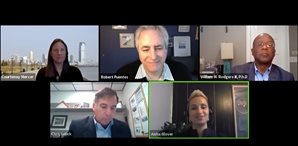
Transportation is an “essential building block of the American economy,” Robert Puentes, CEO and President of the Eno Center Transportation, said during his keynote speech at the NJTPA’s recent symposium,
Creating Opportunity Through Transportation. The symposium was part of the NJTPA’s ongoing outreach for
Plan 2050: Transportation, People, Opportunity.
“Transportation enables global trade, empowers businesses, connects workers to their jobs, creates opportunities for struggling communities, and it provides America an opportunity to be protected from an unpredictable natural environmental,” Puentes said.
Puentes said historically some transportation investments, like the interstate highway system, hindered economic opportunity because they cut through predominately Black and minority communities, isolating people from jobs and opportunities elsewhere in the region.
“Transportation is not important for what it is, it’s important for what it does,” he said, noting that without access to cars or public transit, many minority communities are still cut off from opportunities today.
Puentes noted that 11 percent of the workforce is directly employed in the infrastructure industry – most in transportation. The majority of those workers are truck and bus drivers, he said.
Following his keynote address, Puentes joined a panel discussion featuring Aisha Glover, Vice President of Urban Innovation at Audible; Chris Lutick, Director of Government Affairs for UPS; and William M. Rogers III, Chief Economist at the Heldrich Center for Workforce Development at Rutgers University.
Lutick, who began his career at UPS as a driver, noted that there is still a nationwide truck driver shortage even though the job pays well and provides workforce training. There’s also a need for mechanics and maintenance employees. UPS pays for dedicated bus lines to transport workers from urban centers to job sites to encourage more people to take advantage of the company’s employment opportunities, he said.
Aside from the driver shortage, some of the biggest challenges for UPS are congestion and truck parking, he said. The company is exploring different ways to move freight to reduce congestion, this includes bicycle deliveries, and innovative technologies such as automation and drones.
Glover, who previously served as President and CEO of Invest Newark and then the Newark Alliance before joining Audible, said in addition to accessible transit to get workers to jobs, pedestrian access and walkability are also key. If an area is walkable, there will be less need for corporations to provide shuttles from a train station to an office building, which can add to congestion, she said.
Glover said corporations can also place a greater emphasis on employing people who live in the community. For example, only 18 percent of Newark residents work in the city, she said.
“We can’t just build to think about who else we want to come in, we have to think about existing residents and mobility,” she said. She noted that Audible has supported downtown Newark by providing vouchers to employees to patronize local restaurants and, during the pandemic, supporting restaurants in providing meals for struggling residents.
Rogers suggested creating a program to acknowledge companies that are good corporate citizens, similar to the Leadership in Energy and Environmental Design (LEED) program, a globally recognized program that certifies “green” buildings. He said companies that invest in the human capital – such as hiring people that live and spend money in the community – could be recognized through a certificate program.
But Rogers said transportation also plays a critical role in helping people rise out of poverty. He said creating a stronger, more efficient transportation system can connect people to higher paying jobs and free up more time in their day to spend with their families or supporting businesses in their communities.
He also said the COVID-19 pandemic has highlighted the need to think about future transportation investments differently and said the federal government could provide guidance to local and regional governments.
“As we redesign transportation or as we do new investments, we probably now have to take into account the fact that density matters because we are going to see other types of viruses that are going to unfortunately hit us,” Rogers said.
Puentes said the United States needs to do more to advance technologies that can help maximize the use of the existing transportation network, better sharing space and improving the flow of goods and people.
“We’re woefully outdated and outmoded here in this country,” he said. “There’s so much more we can do here to squeeze as much as we can out of the existing system.”
The discussions at the symposium (and the previous two in the TPA Tuesdays series) are being used in the development of Plan 2050. To learn more visit
njtpa.org/Plan2050.